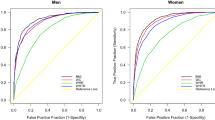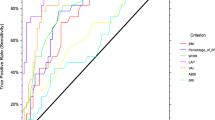Abstract
Objective:
To test the validity of internationally accepted waist circumference (WC) action levels for adult Asian Indians.
Design:
Analysis of data from multisite cross-sectional epidemiological studies in north India.
Subjects:
In all, 2050 adult subjects >18 years of age (883 male and 1167 female subjects).
Measurements:
Body mass index (BMI), WC, waist-to-hip circumference ratio, blood pressure, and fasting samples for blood glucose, total cholesterol, serum triglycerides, and high-density lipoprotein cholesterol.
Results:
In male subjects, a WC cutoff point of 78 cm (sensitivity 74.3%, specificity 68.0%), and in female subjects, a cutoff point of 72 cm (sensitivity 68.7%, specificity 71.8%) were appropriate in identifying those with at least one cardiovascular risk factor and for identifying those with a BMI >21 kg/m2. WC levels of ⩾90 and ⩾80 cm for men and women, respectively, identified high odds ratio for cardiovascular risk factor(s) and BMI level of ⩾25 kg/m2. The current internationally accepted WC cutoff points (102 cm in men and 88 cm in women) showed lower sensitivity and lower correct classification as compared to the WC cutoff points generated in the present study.
Conclusion:
We propose the following WC action levels for adult Asian Indians: action level 1: men, ⩾78 cm, women, ⩾72 cm; and action level 2: men, ⩾90 cm, women, ⩾80 cm.
This is a preview of subscription content, access via your institution
Access options
Subscribe to this journal
Receive 12 print issues and online access
$259.00 per year
only $21.58 per issue
Buy this article
- Purchase on Springer Link
- Instant access to full article PDF
Prices may be subject to local taxes which are calculated during checkout
Similar content being viewed by others
References
Lean ME, Han TS, Morrison CE . Waist circumference as a measure for indicating need for weight management. BMJ 1995; 311: 158–161.
Han TS, van Leer EM, Seidell JC, Lean ME . Waist circumference action levels in the identification of cardiovascular risk factors: prevalence study in a random sample. BMJ 1995; 311: 1401–1405.
Lemieux S, Prud'homme D, Bouchard C, Tremblay A, Despres JP . A single threshold value of waist girth identifies normal-weight and overweight subjects with excess visceral adipose tissue. Am J Clin Nutr 1996; 64: 685–693.
Misra A . Revision of limits of body mass index to define overweight and obesity are needed for the Asian ethnic groups. Int J Obes Relat Metab Disord 2003; 27: 1294–1296.
WHO Expert Consultation. Appropriate body-mass index for Asian populations and its implications for policy and intervention strategies. Lancet 2004; 363: 157–163.
Song MY, Kim J, Horlick M, Wang J, Pierson Jr RN, Heo M et al. Prepubertal Asians have less limb skeletal muscle. J Appl Physiol 2002; 92: 2285–2291.
Chowdhury B, Lantz H, Sjostrom L . Computed tomography-determined body composition in relation to cardiovascular risk factors in Indian and matched Swedish males. Metabolism 1996; 45: 634–644.
Misra A, Vikram NK . Insulin resistance syndrome (metabolic syndrome) and obesity in Asian Indians: evidence and implications. Nutrition 2004; 20: 482–491.
Seidell JC, Kahn HS, Williamson DF, Lissner L, Valdez R . Report from a Centers for Disease Control and Prevention Workshop on use of adult anthropometry for public health and primary health care. Am J Clin Nutr 2001; 73: 123–126.
Vikram NK, Pandey RM, Misra A, Sharma R, Devi JR, Khanna N . Non-obese (body mass index <25 kg/m2) Asian Indians with normal waist circumference have high cardiovascular risk. Nutrition 2003; 19: 503–509.
Snehalatha C, Viswanathan V, Ramachandran A . Cutoff values for normal anthropometric variables in Asian Indian adults. Diabetes Care 2003; 26: 1380–1384.
Misra A, Pandey RM, Devi JR, Sharma R, Vikram NK, Khanna N . High prevalence of diabetes, obesity and dyslipidaemia in urban slum population in northern India. Int J Obes Relat Metab Disord 2001; 25: 1722–1729.
Vikram NK, Misra A, Dwivedi M, Sharma R, Pandey RM, Luthra K et al. Correlations of C-reactive protein levels with anthropometric profile, percentage of body fat and lipids in healthy adolescents and young adults in urban North India. Atherosclerosis 2003; 168: 305–313.
Gupta R, Gupta VP, Sarna M, Bhatnagar S, Thanvi J, Sharma V et al. Prevalence of coronary heart disease and risk factors in an urban Indian population: Jaipur Heart Watch-2. Indian Heart J 2002; 54: 59–66.
World Health Organization. Physical status: the use and interpretation of anthropometry. Report of a WHO Expert Committee. World Health Organization: Geneva, 1995, pp 424–438. WHO Technical Report Series, No. 854.
Misra A, Vikram NK, Arya S, Pandey RM, Dhingra V, Chatterjee A et al. High prevalence of insulin resistance in postpubertal Asian Indian children is associated with adverse truncal body fat patterning, abdominal adiposity and excess body fat. Int J Obes Relat Metab Disord 2004; 28: 1217–1226.
Gupta R, Prakash H, Kaul V . Cholesterol lipoproteins, triglycerides, rural–urban differences and prevalence of dyslipidaemia among males in Rajasthan. J Assoc Physicians India 1997; 45: 275–279.
Friedewald WT, Levy RI, Fredrikson DS . Estimation of the concentration of low-density lipoprotein cholesterol in plasma without use of the preparative ultracentrifuge. Clin Chem 1972; 18: 499–502.
Executive Summary of the Third Report of the National Cholesterol Education Program (NCEP) Expert Panel on Detection, Evaluation, and Treatment of High Blood Cholesterol in Adults (Adult Treatment Panel III). JAMA 2001; 285: 2486–2497.
The sixth report of the Joint National Committee on prevention, detection, evaluation, and treatment of high blood pressure. Arch Intern Med 1997; 157: 2413–2446.
American Diabetic Association. Report of the Expert Committee on the Diagnosis and Classification of Diabetes Mellitus. Diabetes Care 2003; S5–S20.
Molarius A, Seidell JC, Sans S, Tuomilehto J, Kuulasmaa K . Varying sensitivity of waist action levels to identify subjects with overweight or obesity in 19 populations of the WHO MONICA Project. J Clin Epidemiol 1999; 52: 1213–1224.
Okosun IS, Rotimi CN, Forrester TE, Fraser H, Osotimehin B, Muna WF et al. Predictive value of abdominal obesity cut-off points for hypertension in blacks from West African and Caribbean island nations. Int J Obes Relat Metab Disord 2000; 24: 180–186.
Velasquez-Melendez G, Kac G, Valente JG, Tavares R, Silva CQ, Garcia ES . Evaluation of waist circumference to predict general obesity and arterial hypertension in women in Greater Metropolitan Belo Horizonte, Brazil. Cad Saude Publica 2002; 18: 765–771.
Berber A, Gomez-Santos R, Fanghanel G, Sanchez-Reyes L . Anthropometric indexes in the prediction of type 2 diabetes mellitus, hypertension and dyslipidaemia in a Mexican population. Int J Obes Relat Metab Disord 2001; 25: 1794–1799.
Mirmiran P, Esmaillzadeh A, Azizi F . Detection of cardiovascular risk factors by anthropometric measures in Tehranian adults: receiver operating characteristic (ROC) curve analysis. Eur J Clin Nutr 2004; 58: 1110–1118.
McNeely MJ, Boyko EJ, Shofer JB . l. Standard definitions of overweight and central adiposity for determining diabetes risk in Japanese Americans. Am J Clin Nutr 2001; 74: 101–107.
Lin WY, Lee LT, Chen CY, Lo H, Hsia HH, Lui IL et al. Optimal cut-off values for obesity: using simple anthropometric indices to predict cardiovascular risk factors in Taiwan. Int J Obes Relat Metab Disord 2002; 26: 1232–1238.
Bei-Fan Z . Predictive values of body mass index and waist circumference for risk factors of certain related diseases in Chinese adults: study on optimal cut-off points of body mass index and waist circumference in Chinese adults. Asia Pac J Clin Nutr 2002; 11 (Suppl 8): S685–S693.
Ardern CI, Janssen I, Ross R, Katzmarzyk PT . Development of health-related waist circumference thresholds within BMI categories. Obes Res 2004; 12: 1094–1103.
Moy FM, Atiya AS . Waist circumference as a screening tool for weight management: evaluation using receiver operating characteristic curves for Malay subjects. Asia Pac J Public Health 2003; 15: 99–104.
Banerji MA, Lebowitz J, Chaiken RL, Gordon D, Kral JG, Lebovitz HE . Relationship of visceral adipose tissue and glucose disposal is independent of sex in black NIDDM subjects. Am J Physiol 1997; 273: E425–E432.
Raji A, Seely EW, Arky RA, Simonson DC . Body fat distribution and insulin resistance in healthy Asian Indians and Caucasians. J Clin Endocrinol Metab 2001; 86: 5366–5371.
Chandalia M, Abate N, Garg A, Stray-Gundersen J, Grundy SM . Relationship between generalized and upper body obesity to insulin resistance in Asian Indian men. J Clin Endocrinol Metab 1999; 84: 2329–2335.
Acknowledgements
This study was partially supported by a grant from the Science and Society Division, Department of Science and Technology, Ministry of Science and Technology, Government of India and by a perpetual grant from Monilek Hospital and Research Centre, Jaipur, India. Mr Ramesh Giri assisted in anthropometry and body fat measurement, and Mr Inder Taneja, Mr Gian Chand, and Mrs Alice Jacob performed biochemical investigations and insulin assay. Ms Seema and Mrs Jyoti helped in the preparation of manuscript. The cooperation of the subjects who took part in the study is greatly appreciated.
Author information
Authors and Affiliations
Corresponding author
Rights and permissions
About this article
Cite this article
Misra, A., Vikram, N., Gupta, R. et al. Waist circumference cutoff points and action levels for Asian Indians for identification of abdominal obesity. Int J Obes 30, 106–111 (2006). https://doi.org/10.1038/sj.ijo.0803111
Received:
Revised:
Accepted:
Published:
Issue Date:
DOI: https://doi.org/10.1038/sj.ijo.0803111
Keywords
This article is cited by
-
Correlation between the triglyceride-glucose index and arterial stiffness in Japanese individuals with normoglycaemia: a cross-sectional study
BMC Endocrine Disorders (2024)
-
Bio-demographical determinants of diabetes among women in reproductive age group (15–49) in India: Evidence from National Family Health Survey (NFHS) of India, 2019–2021
International Journal of Diabetes in Developing Countries (2023)
-
Incidence and predictors of metabolic syndrome in Asian-Indians: a 10-year population-based prospective cohort study
International Journal of Diabetes in Developing Countries (2023)
-
Influence of smartphone-based physical activity intervention on executive functions and cardiometabolic disease risk in obese young adults: a pilot randomised controlled trial
Journal of Diabetes & Metabolic Disorders (2023)
-
Cutoff values of body fat composition to predict metabolic risk factors with normal waist circumference in Asian Indian population
European Radiology (2022)



